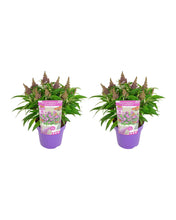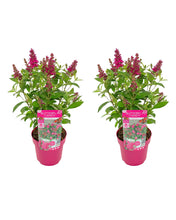Buddleja davidii, commonly known as the butterfly bush or summer lilac, is a popular and vigorous deciduous shrub prized for its long, fragrant flower panicles and ability to attract butterflies. This Buddleja species features arching branches with lance-shaped, grey-green leaves and produces cone-shaped or cylindrical flower clusters in a wide range of colours, including purple, pink, white, and red, from mid-summer to autumn. Its abundant flowers and sweet fragrance make it a favourite for gardens and landscapes, attracting pollinators like butterflies and bees. It belongs to the Scrophulariaceae family.
Origin: Buddleja davidii is native to China and Japan.
Light: Buddleja davidii thrives in full sun. It prefers at least 6-8 hours of direct sunlight per day to encourage optimal growth and flowering.
Water: Water regularly, especially during dry periods and the first year after planting. Buddleja davidii prefers consistently moist, well-drained soil. Avoid overwatering, which can lead to root rot.
Soil: Buddleja davidii can tolerate a range of soil types, but prefers well-drained soil. It thrives in fertile, loamy soil.
Fertilising: Feed your Buddleja davidii with a balanced slow-release fertiliser in spring.
Pruning: Buddleja davidii benefits from regular pruning to maintain shape and promote flowering. Prune hard in late winter or early spring, cutting back the previous year's growth to about 30cm (12 inches) from the ground. This will encourage vigorous new growth and abundant flowering.
Pests and Diseases: Buddleja davidii is generally pest and disease resistant, but keep an eye out for spider mites and caterpillars.
Uses: Buddleja davidii is primarily grown as an ornamental shrub for its attractive and fragrant flowers, which attract butterflies and other pollinators. It's a popular choice for gardens, borders, and wildlife gardens.
Toxicity: Buddleja davidii is not known to be toxic to humans or pets. However, it's always best to keep plants out of reach of children and pets who might try to eat them.
Invasive Potential: In some regions, Buddleja davidii can be invasive, spreading readily by seed. It's important to be aware of its potential invasiveness and take steps to control its spread if necessary, such as deadheading spent flowers to prevent seed formation.





